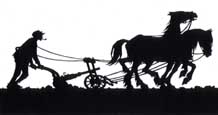Born
on 13 ApriI 1903 at Essen, ninth son of artiIIery officer and
construction engineer Bernhard SIuyterman v. Langeweyde. His mother's
famiIy comes from Lower Saxony, his father's from the Netherlands. The
originaI spelling of his name was Sluyterman Van Langeweyde (the
particle « Van ), Germanized to « von », is most often written by him in
the abbreviated form of : « v » ) .After the early death of his father
(1908), spends a very poor youth in a working district in Essen. Takes
part in the activities of the Wandervogeland learns to play the guitar.
Works for a time as a miller in Pomerania and in a publicity firm. In
1920, enrolls at the Essen Arts-and-Crafts School, where he attends the
courses of Wilhelm Poetter (graphic art and decoratiye painting) and
Hermann Kätelhön (wood-engraving). Completes his training at the
Dusseldorf Academy, where he is the pupil of Fritz Mackensen and Spatz,
then the Meisterschüler of Julius Paul Junghanns. Settles as graphic
artist at Düsseldorf. Marries in 1926. Joins the NSDAP on 1 May 1928,
which immediately results in his losing several commissions | |  |
Also becomes a member of the
SA. An enthusiastic member of the national-socialist movement at the
same time as his elder brother, Wolf Sluyterman v. Langeweyde, who is
then unemploxyed. Does posters, vignettes, caricatures. Draws the
heading of the weekly newspaper of the Dusseldorf Gau of the NSDAP, Die
Neue Front, and contributes regularly to it, becomes known mainly for
his engravings on wood and lino, which deal with rustic Iife in Lower
Saxony and the landscapes of the Luneburg Heath. Working in the style of
the old masters, praises the world of work and illustrates numerous
historical subjects. Incorporates into his engravings quotations,
proverbs, and phrases from Volkslieder. In 1935, the Folkwang Museum in
Essen buys severaI of his works. He then does three major series of
engravings (Des Deutschen Volkes Lied 1935, Es mahnen die Vater 1936,
Deutsches Lied 1938) which make him very popular and are often
reproduced in the press (Der Schulungsbrief, Junges Volk, etc.). AIso
does some politicaI engravings, as well as a portrait of Hitler, and
contributes to selections of the series Ewiges Deutschland. Executes
severaI murals for hostels of the Hitler Youth and of the SA. Exhibits
one litho at the GDK in 1939. Settles in 1940 at Bendestorf; near
Hamburg. The following year, volunteers for the Eastern Front. Some of
his works are destroyed at the end of the war. Is captured by the
British, then interned for more than a year. After the war, attempts to
continue his career in difficult circumstances. To earn his Iiving he
does mainly publicity and commerciaI drawings. Remarries in 1946. Turns
towards painting in the fifties. Also writes poems, ballads, and songs
in the spirit of the songs of Hermann Lons, which he sings himself while
accompanying himself on the guitar (brings out a record in 1970).
Receives in 1970 the Ring of Honour in gold of the Deutsches Kulturwerk
Europaischen Geistes. His engravings are published again and distributed
mainly from 1975 on by the Uwe Berg publishing house. Dies on 5 January
1978 in his house at Bendestorf ("Haus Malershöh").He is buried at the
Heidefriedhof in Bendestor (The Landkreis of Harburg awards him
posthumously its Culture Prize. Is also made an honorary citizen of
Bendestor. His wife Eva-Maria dies shortly after him. |


